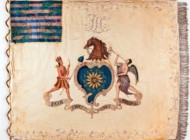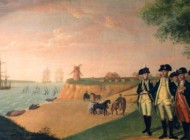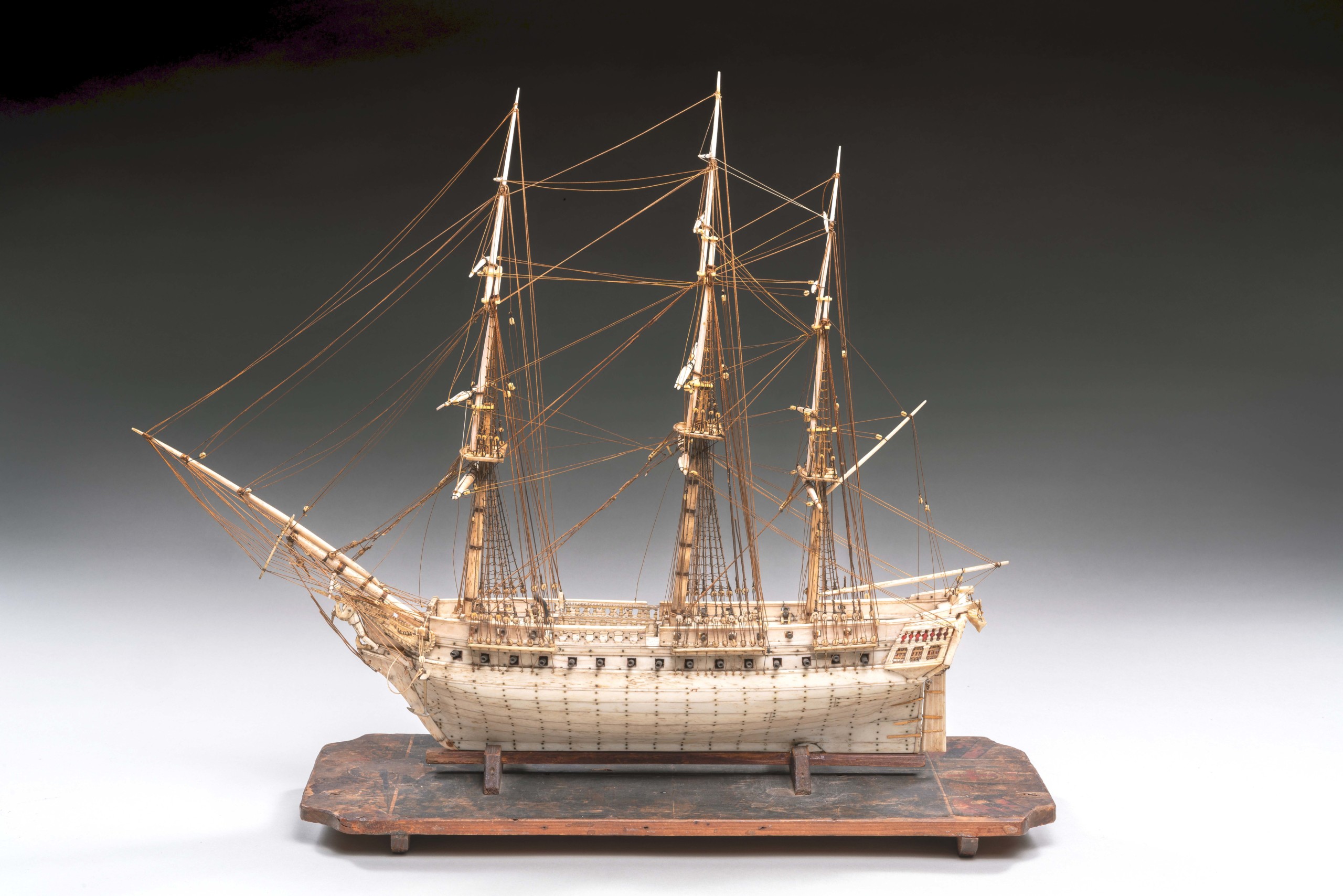
Napoleonic War model of an unidentified British frigate, attributed to an unknown prisoner in Dartmoor Prison, England, circa 1790-1820, bone, on a paper-covered wood stand, 12 by 16 inches. Gift of Elizabeth C. Blaisdell. Photo courtesy of Independence Seaport Museum.
By Madelia Hickman Ring
PHILADELPHIA — The four corners of the globe, once only accessible by boat, have captivated people around the world for centuries, enchanting them with promises of adventure, exploration or profit. Such global intrigue was manifested in small-scale vessels, enjoyed by those living in land-locked areas as well as coastal regions. These diminutive vessels were made for different reasons. Half-hull models, used to build larger vessels, revealed design sources. Pond models were raced for sport. Others were made as toys for children while highly crafted, expensive models appealed to older audiences. For ship builders or ship owners, replicas commemorated their full-scale accomplishments or prized possessions; passengers liked to have souvenirs of sailed voyages. Some, made by prisoners of war, were crafted to be used in exchange for food.
The Independence Seaport Museum (ISM) has been collecting model ships since its founding in 1960, and nearly 50 examples, dating from the early Nineteenth Century to the later Twentieth Century, are now on view in the museum’s recently opened permanent exhibition, “Small But Mighty!: Models, Toys and Miniature Ships.” Related paintings and prints provide context for the ships, which were all made from scratch, from wood, paper, bone and metal; none are from kits.
Peter S. Seibert, the museum’s president and CEO, shared with Antiques and The Arts Weekly the reasons behind the exhibition and what he and his team were aiming for as they pulled it together:
“When I started at the museum four years ago, we began to reconfigure several under-utilized gallery spaces. One of our temporary solutions was the installation of a handful of model ships from our extensive collection. The public response was very strong and prompted us to consider a larger and more permanent installation of the models. My sense is that we have always had model ships on exhibition at the ISM, but this may be the first time that we have shown both so many and in one centralized location.”

Heavy cruiser USS Indianapolis, made by Walter H. Gerber (1900-1986), Philadelphia, 1934-1938, wood, brass, mechanicals, wiring, 26 by 12 inches. Acquired through exchange courtesy of friends of the museum. Photo courtesy of Independence Seaport Museum.
Seibert continued, “In selecting examples for the exhibit, we tried to pick out examples that represented the entire gamut of ships — from pond models to tabletop dioramas, from copies of military warships to half hulls used in building a ship. We wanted to showcase models that have multiple levels of interpretation. The model of the USS Indianapolis is such an example. Everyone knows the story of the real Indianapolis, but the discovery that the maker of our model was suspected of being a spy opens up a whole new level of interpretation.”
Seibert noted that though it’s often difficult to pinpoint when the models were made because they were not usually dated and lagged behind “big ship” technology, the exhibition includes several half-hull models that can be traced back to the late Eighteenth and early Nineteenth Century. Among these is his personal favorite, a bone model made circa 1812-14 by French sailors held prisoner in Britain’s Dartmoor Prison during the Napoleonic War era. Modeling an unidentified British frigate with 50 guns and a decorative paper-covered stand, it was given by US Navy Commodore Charles Stewart to David Bruce, Sr, at Bordentown, N.J., around 1820.
Of similar vintage is an unidentified Delaware River schooner made circa 1800-20 by Phillip Rice (1769-1829) in Dorchester, N.J.
Mid Nineteenth Century objects are comparatively more plentiful. Two with connections to Philadelphia are represented by a half-hull model of the City Ice Boat, made in Philadelphia around 1850 by Jacob Tees, Sr, (1790-1875), followed a few decades later by John Dene Benton’s (1824-1890) gilt copper and silver alloy model of the tugboat, Lizzie of Philadelphia.
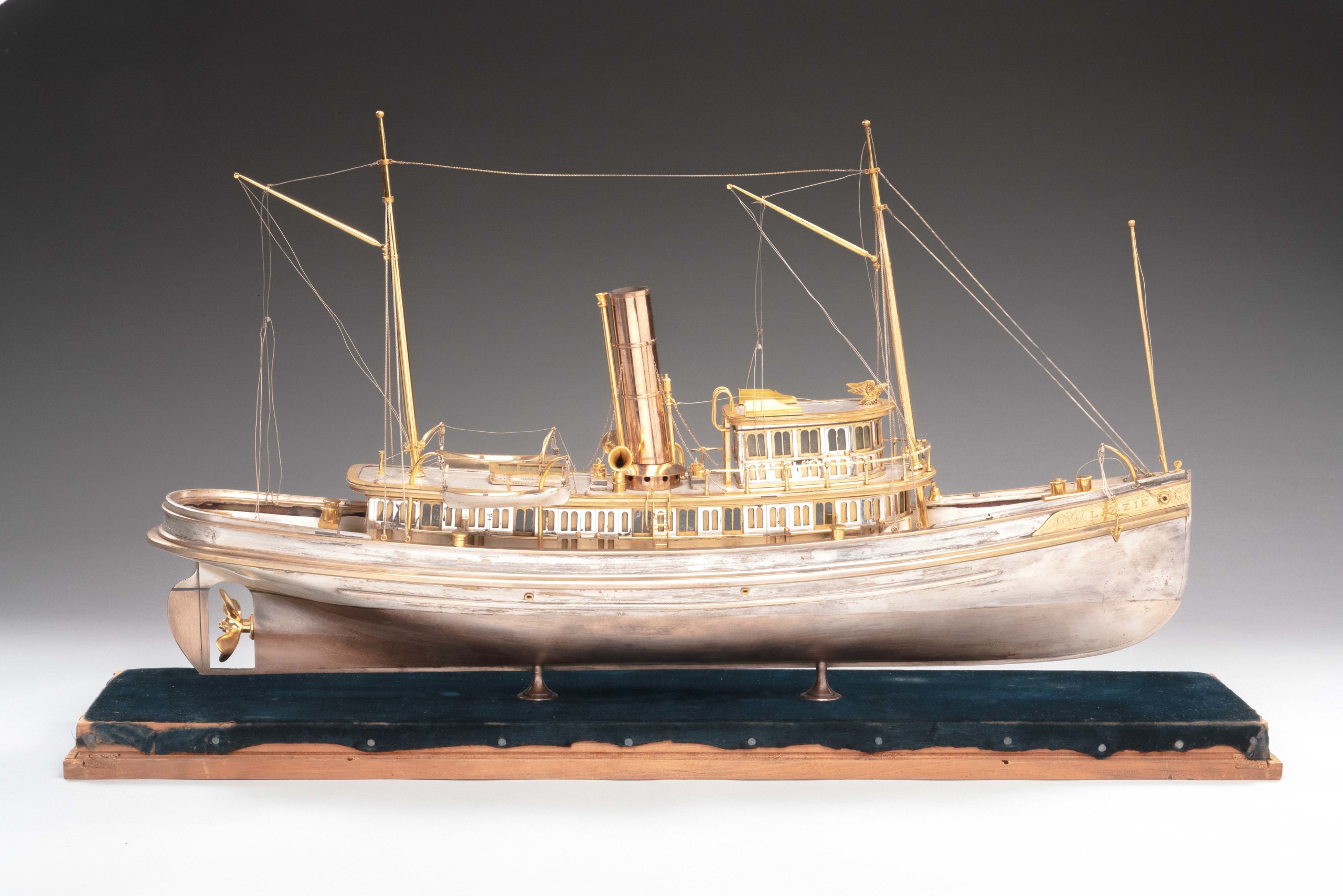
Tugboat Lizzie of Philadelphia, made by John Dene Benton (1824-1890), Philadelphia, 1870s, copper and silver alloys with gilding, 20 inches high by 33 inches long. Acquired through exchange courtesy of J. Welles Henderson. Photo courtesy of Independence Seaport Museum.
In the 1870s, model ship racing began in England, eventually taking hold as a popular sport in the United States, where some public park lakes, including New York City’s Central Park Lake, were built solely for this purpose. Races were held in both open water and on ponds with organizations created that established rules and organized regattas. “Small But Mighty!” identifies five classes of model yachts that spanned a range of sizes and costs. An exemplary “M” class model in the exhibition is the Almary II, made in 1949 by Albert Link, which is considered one of the biggest and best of its kind.
Toy ships are a significant category in the exhibition, in varying vintages and from a broad range of manufacturers. Among the earliest of these is the steamer Priscilla, made with lithographed paper on board and wood around 1896 by the R. Bliss Manufacturing Company in Pawtucket, R.I. A quarter century later, around 1920, German toy makers Märklin and Company released a model of the USS Baltimore.
The museum made sure to include some of the public’s longtime favorites, one of which is the heavy cruiser USS Indianapolis, which Seibert said was “remembered both as the ship that delivered the atomic bomb that ended the Second World War and also for the horrific shark attack on her crew after the Indianapolis was torpedoed and sunk” (and, which, interestingly, was recounted in the movie Jaws by Indianapolis survivor, Captain Quint, played by actor Robert Shaw).
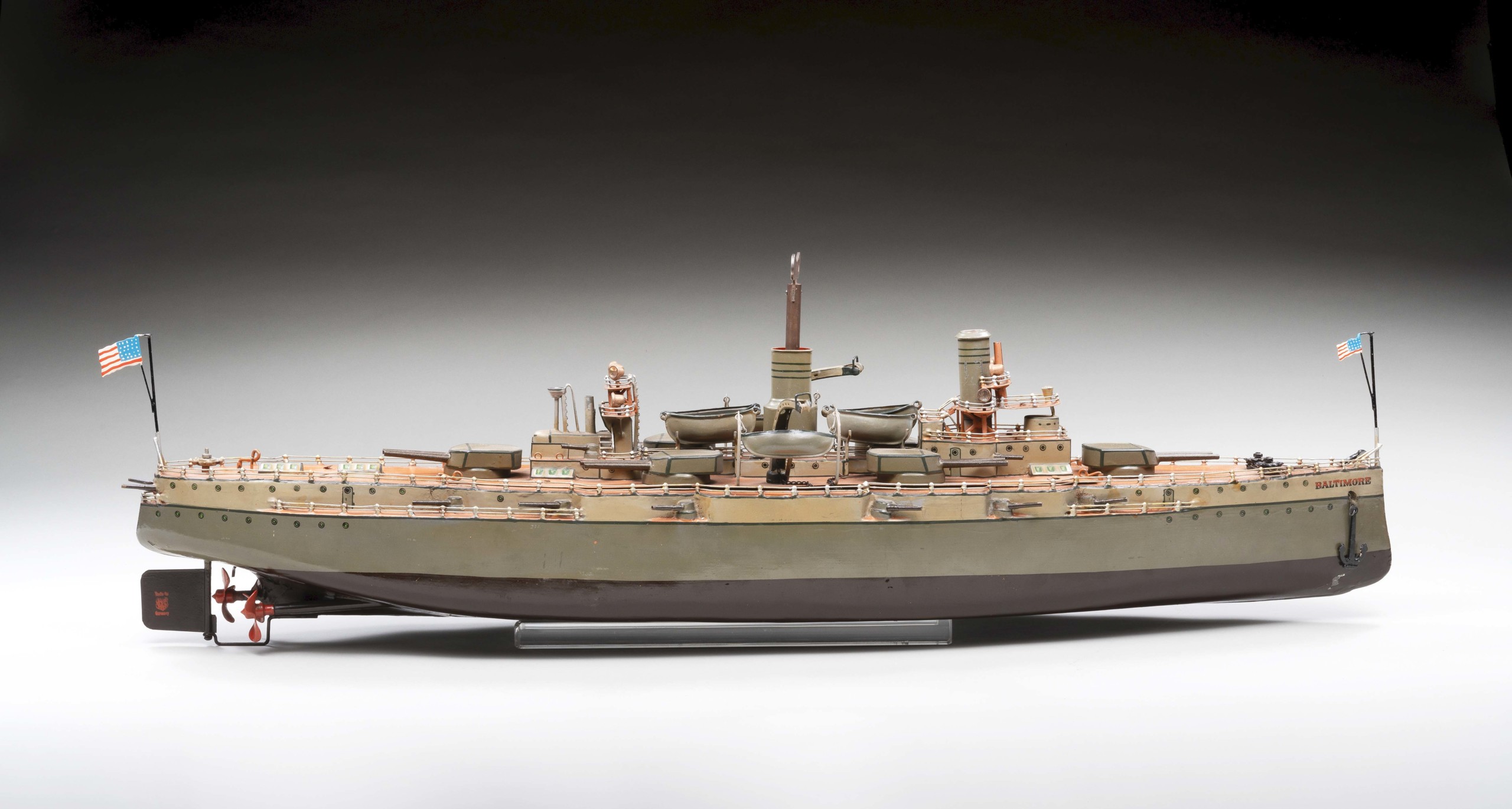
USS Baltimore, made by Märklin and Co., Göppingen, Baden-Württemberg, Germany, circa 1920, lithographed tin, mechanical device, 10½ by 58 inches. Gift of Dr Lester Steppacher. Photo courtesy of Independence Seaport Museum.
More recent acquisitions are included as well. Among these, a folk art steam dredge that Seibert noted employed the team’s scholarly acumen and also challenged their powers of observation. “An example is the model of a dredge that we just acquired at auction. Sadly, there was no provenance on it. The model, to be honest, is pretty crude but it is built totally by hand without a kit or prefabricated tools. Thus it clearly reflects the skill of someone who actually knew how a dredge worked.”
What does Seibert want visitors to take away from seeing the exhibition? “Go home and build a boat model! All kidding aside, the models in the exhibition are a reflection of the pride of each maker. Most are totally built from scratch with the maker carving or casting or turning or hammering every element. They reflect an immense creative spirit that I hope inspires and impresses everyone!”
The Independence Seaport Museum is at 211 South Christopher Columbus Boulevard. For information, 215-413-8655 or www.phillyseaport.org.
















